|
Home | About MIAS.Aero | Articles and Publications | Airforces Overview | Projects | Links | Contact | NATO PfP CO-OPERATIVE KEY 2001: Co-operative Key 2001 exercise was the fifth in a series of live air exercise planned and led by Nato's AFSOUTH since 1996 and marked the first time that the North Atlantic Treaty alliance officially graded members of Partnership for Peace (PfP) on sky worthiness. After nearly a year of preparation, this year's most important Partnership for Peace-exercise took place from Sept. 11 to 21 place in the area between the airbases of Graf Ignatievo and Krumovo situated North and South of Bulgaria's second largest city Plovdiv and the Koren Range located near the Greek/Turkish border, 75 miles SE of Plovdiv. 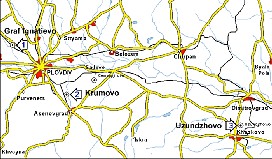
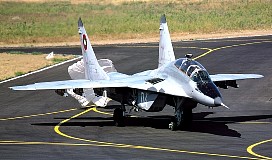
Initially overshadowed by the horrific September 11th attacks in the USA , NATO and it's PfP partners almost immediately decided to go ahead by all means. This as a very firm statement to express the seriousness and great importance of these exercises to all participants, specifically to those in that region. But moreover it confirmed the commitment and determination of all partners that through dialogue and co-operation, potential crisis and terrorism is to be put to a halt and eliminated and when necessary to be dealt with as one group, that is better trained and prepared. Besides 3 US Navy MH-53E Sea Dragons from Helicopter Combat Support Squadron 4 being called back to their home base at NAS Sigonella Italy, all the participants and aircraft stayed until the end without any mission being cancelled resulting in over 450 sorties made out of Graf Ignatievo and more than 70 from Krumovo. Being the largest NATO/PfP exercise in 2001, CK '01 saw ten NATO countries participating: Belgium, Canada, France, Greece, Hungary, Italy, The Netherlands, Poland, Turkey and the United States of America as well as fourteen PfP countries; Austria, Azerbaijan, Bulgaria, Croatia, Finland, FYROM, Georgia, Latvia, Moldavia, Romania, Slovakia, Slovenia, Sweden and Switzerland participating with 32 fighters, 11 transport-aircraft, 20 helicopters and 1.600 troops. New elements in the CK-series of exercises were the official introduction of assessment, Combat Search and Rescue (CSAR), the use of photo-reconnaissance aircraft and the co-operation with the United Nations High Commissioner for Refugees (UNHCR), the Bulgarian Red Cross and other non-military organisations. BULGARIA AND NATODuring the Cold War, Bulgaria was one of the Soviet Union's most capable weapons producers, and the Bulgarian military was
ready to help crank up the war machine in a moments notice. Since the fall of communism, however, Bulgaria's national security
concerns have changed. "We have no enemies," said then Defence Minister Georgi Ananiev, who under Bulgarian law is a civilian.
"We are at peace with all our neighbours." Clearly a break was made with the communist definition of what defines national
security and security is now directly linked to economic, political, sociological factors. Major General Stoyan Tzonkov,
defence attaché for the Bulgarian embassy in Washington stated: "NATO members are now realising that Bulgaria's military
reform is genuine, and that if an invitation is extended the country will be a capable NATO ally. "We don't want to just be
consumers of security - we want to be producers too". Bulgaria for some time has been preparing itself to team up with
organisations promoting Euro-Atlantic and regional security.
PfP & IPPAlthough some Central and East European (CEE) politicians initially saw the Partnership for Peace (PfP) program as palliative
(no enlargement), PfP did move non-NATO members beyond dialogue and into practical partnership. PfP developed a framework and
process while it established the norm that partners should be "contributors" and marked a shift from purely multilateral dialogue
to bilateral (partner and Alliance) relationships in the form of Individual Partnership Programs (IPPs) and self-differentiation.
Bulgaria was the eighth country in Central Europe to join the PfP Program when former President Zhelyu Zhelev signed the PfP-framework
agreement in 1994, and the fourth to submit a PfP Presentation Document.
BULGARIAN EFFORTSSimilar to last years Co-operative Key 2000 exercise held by the Romanians at Mihail Kogalniceanu airbase near Constanta, hostnation
Bulgaria invited this years participants to their fully NATO-standardised airbase of Graf Ignatievo. Many of the buildings (including
some original German Luftwaffe heritage of WW II) were completely rebuild while other items like the control tower, flightline
operations centre, base HQ, cinema, housing- and dining facilities and communications structure underwent a complete makeover.
The north-side shelter area was used for parking the participating helicopters which included 3 Austrian and a single Italian Agusta
Bell AB-212, 2 Slovenian Bell 412s, 2 Hungarian Mi-8s, a single Slovak Mi-17, a Swiss Super Puma and 2 Romanian SOCAT upgraded Pumas.
The NAS Sigonella based HC-4 "Black Stallions " sent three of their US Navy MH-53s, but were quickly recalled after the September 11th
attacks. The four Bulgarian Mi-17s and Mi-24s (two of each) operated separately from a platform located at the west-end of the runway.
At Krumovo airport, which is partly controlled by the civilians airport authorities, both the parking ramp and runway were renewed. Landing lights, a new fence, a rail road crossing and a newly paved access road to the civil terminal were also installed. The civilian ramp at Krumovo was used exclusively for the transport aircraft, which could easily drop off or take in refugees or casualties from the Dutch field hospital or specially for the exercise built UNHCR refugee camp, complete with tents, watchtower, barbed wire and guardians. The military side of Krumovo located south of the runway houses the 24 VAB. Visible but not participating were large numbers of helicopters which included Mi-8/17s, Mi-24s and some An-2 Colts. A most impressive achievement considering that the works at both bases had started only at the end of May 2001 and the entire renovation was completed in a record-short period of three and a half months by the Stara Zagora based Putstroy Engineering company. Many of the AIRSOUTH participants, who during the preparation phase had visited Bulgaria, were truly impressed that all the tasks were completed in time. These Bulgarian efforts must also be seen in a wider perspective. In 1996 the Bulgarian Army started a reform process with the development of a fifteen year program called Plan 2010 which was accelerated and refine in the reform plan 2004. This plan includes a rebuilding of the organisational structure of the Air Force, downsizing of personnel, modernisation of equipment and infrastructure, maintaining readiness of forces for PSO and fulfilling the 22 Partnership goals which contribute to achieving the necessary interoperability with the Alliance. This also means that many of the Bulgarian airbases are being closed. It is believed that Bezmier, Graf Ignatievo, Kamenetz and Krumovo will remain. THE EXERCISE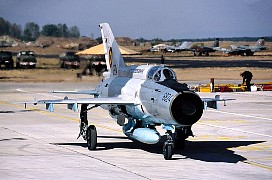
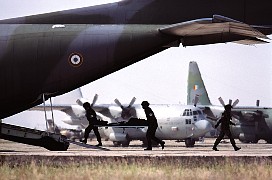
The overall aim of these type of exercises is to allow NATO and Partner nations to practise and refine interoperability in air and land operations in support of Peace Support Operations (PSO) and assess capabilities of offered Partner forces, while participants learn and master the NATO standard procedures and terminology for communications, logistics, planning, safety, etcetera. Through a series of conferences and workshops which started as far back as October 2000 (!), the participating units were gradually prepared by training the trainers who passed their knowledge on to individual countries in preparation of the exercise. EVENTS: DATE: LOCATION: " Pre- Initial Operational Planning Conference 10-14 Oct. 2000 Sofia, Bulgaria " Initial Planning Conference (IPC) 12-14 Dec. 2000 Garmisch-Partenkirchen, Germany " Initial Operational Planning Conference 13-15 Feb. 2001 Neuseidl am See, Austria " Site Survey 06-08 Mar. 2001 Plovdiv, Bulgaria " Main Planning Conference (MPC) 24-26 Apr. 2001 Naples, Italy " Workshop 1 07-10 May 2001 Sofia, Bulgaria " Final Planning Conference (FPC) 19-21 Jun. 2001 Plovdiv, Bulgaria " Workshop 2 11-12 Sept. 2001 Plovdiv, Bulgaria " Co-operative Key 01 - LIVEX 10-21 Sept. 2001 Plovdiv, BulgariaThe official PfP workshop program offers a selection of courses which can be used to build a specific workshop program aimed at these specific PSO exercises (building blocks). The general aims are approved by the COMAFSOUTH and together with the input of the individual participating a final setup is made. Just before the LIVEX kicks off, the final two-day workshop program forms the culmination or last check for all of the training part of the exercise. The first day workshop started with a general exercise briefing given to all participants, after which the aircrews and Air Operation Center (AOC) staff got their briefing on air control procedures, while the land forces were instructed on the planned land ops. Then when the working-day was about to come to an end, the terrible news hit Bulgaria. Besides the disbelieve and immense shock the attacks of September 11 caused, it inevitably also created great uncertainty whether exercise would continue. Since the Americans contributed heavily to the exercise with 4 A-10s, 3 MH-53s and over 150 ground troops including special forces from the Army, USMC, USAF and ANG, their leaving would seriously impact the course of the exercise especially during the ground operations but also at command level since many of the Air South staff were also of American nationality. At the second day of the workshops, it was however decided to continue as planned but without American participation and a whole series of workshops were held on specific exercise areas like logistics, helo operations, land operations, medevac, assessment, air transport, close air support, recce and air defense. In the meanwhile the 3 US Navy MH-53Es had been grouped together with the A-10s in a heavily guarded shelter area and everything indicated that the Americans got ready to leave. The content of the CAS and recce workshops focussed mainly on flight-, safety- and emergency procedures, NATO standards and sharing information on the local airbase procedures, frequencies, etc. During a later session the participating CAS and Recce units introduced their units to their counterparts through a short presentation after which the specific capabilities and equipment of their aircraft were exchanged. The next day the US Navy helicopters indeed did leave while at the exercise command level everything was done to re-schedule the exercise plans without an American involvement. One can imagine the huge task to re-organise something which is created in just under a year which now has to be re-designed in just a few days (and nights). On Thursday the flying part of the exercise started with familiarisation and training sorties, while on Sunday it became clear that the remaining US aircraft and personnel would participate fully again. This meant of course that the exercise plans had to be adapted again resulting in some extreme night-work to get everything ready for the next day. When the first day of the LIVEX kicked off, the program was fully running again and the A-10s were flying their CAS missions, attacking opposing forces defending the former Mig-21 airbase at Uzundhovo.SCENARIOAs the fictional scenario had specifically been designed to address some specific training objectives, the participating aircrew were provided with a framework for training missions they will be tasked to fly during the course of the exercise. The aircraft employed reflect the typical missions areas covered to accomplish a future Peace Support Operation (PSO) and included air assets for deployment /redeployment, Command & Control, Air Defence (AD), Tactical Recce, Search & Rescue (SAR), Close Air Support (CAS), Forward Air Control (FAC), Air Drop (both cargo and troops) and Aeromedical Evacuation. 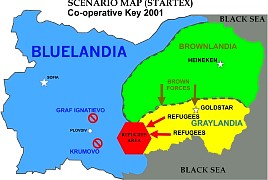
The scenario used in Co-operative Key 2001 revolves around the fighting between the former Federland territories of Brownlandia and Graylandia who are fighting over the scarce natural resources of the former Federland . This has caused refugees and the fighting to spill over into the neighbouring republic of Bluelandia, a PfP nation. NATO and its PfP partners have been asked to come into the area to restore and enforce the peace between the two republics. UN and PSO airlift has been requested to bring emergency aid supplies into GRAYLANDIA. Forward-deployed PSO aircraft are operating from two bases; Graf Ignatievo and Krumovo in BLUELANDIA. At the start of the exercise (STARTEX) a cease-fire between the two ethnic factions has been negotiated by the Office of Security and Co-operation in Europe (OSCE) but tactical recce flights conducted over GRAYLANDIA, show heavy clashes. Regardless the cease-fire, it appears that Brownlandian forces are trying to occupy by force the main cities of GRAYLANDIA resulting in even higher flows of refugees seeking safety. A Demilitarisation Zone (DMZ) and a No Fly Zone (NFZ) are established to protect the PSO Forces and refugees en route to BLUELANDIA. Since only the STARTEX-scenario was released at the beginning of the exercise and the following 'events' were owned exclusively by the Distaff (thus not known to the participants), a true 'free-play' exercise environment was created. A deployed E-3A Airborne Early Warning & Control System (AWACS), controlled the air assets employed and was vital for maintaining and enforcing the No-Fly Zone established over the Area of Operations (AOR). With its airborne down-looking radar continuously patrolling, the AWACS under the callsign Magic provided the commanders with a life picture by downlinking the obtained Recognised Air Picture (RAP) to the unique Dutch Deployable Electronic Counter Measures Communication System Prototype Terminal or DEPT. This DEPT, installed in a truck-mounted military air-transportable shelter provides the capability to exchange aircraft track data with the NATO Airborne Early Warning (NAEW) Force Command. To interface it with military and civil ATC radar, to support operational missions and to display, record and replay digital track data and to distribute data over encrypted Wide Area Network (WAN) and SATCOM links. Normally DEPT interacts with Western Europe's massive air defence system, called the NATO Air Defence Ground Environment (NADGE) network. In exercises like CK01 it allows tactical field deployments at more remote locations and also provide electrical power, since its equipped with a powerful generator, to other vital systems at Grafs AOC. At the start of the day, Swedish Viggens under callsign "Wolf" would fly out in pairs to conduct reconnaissance missions over the AOR while escorted by Bulgarian Mig-21 Bis Fishbed N's for air cover and suppression of ground targets. After the initial gathering of intelligence, a single Bulgarian Su-22-M4 Fitter with a KKR recce-pod covered by either Turkish or Greek F-16C's flew into the AOR to gather further information and help the commanders adjust their plans and assess the effectiveness of the plans. This gathering of information continues throughout the whole exercise period. Pairs of Bulgarian Mig-29 Fulcrums meanwhile swept the AOR and No-Fly Zone under the guidance of Magic (AWACS) to ensure these areas were still safe for further operations. 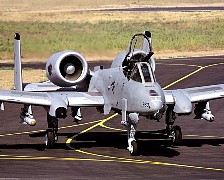
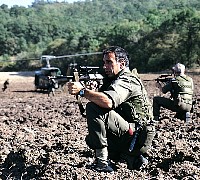
Once the commanders determined that ground troops had to be inserted, air transport aircraft like the Romanian and French C-130s were sent out over the AOR. The incoming paratroopers used High-Altitude, Low Opening or HALO-jumps for quick insertion to secure the area and begin enforcing the peace as well as helping refugees evacuating the area of conflict. Prior to this assault, US special forces were the already on the ground. These included the 123 Special Tactics Squadron, Kentucky ANG and the USMC B-Company, 4th Reconnaissance Battalion from Billings Montana, which already played a major role in last years CK '00 ground operations. Normally tasked with para-rescue, combat control, Air traffic controller (incl. CAS), the ANG contingent set up casualty collection point. Before the ground troops had established their positions, Close Air Support (CAS) was called in to assist with surpressing and eliminating enemy forces. American Thunderbolt A-10s and Bulgarian Su-25K Frogfoots provided the necessary CAS during the exercise, while Bulgarian Mi-24 Hinds gunships flew over the targets in support of the transport or medevac helicopters, securing their arrival. As soon as the area was secured, a role 1 medical facility was established to give initial treatment to the injured. Medevac helicopters like the Italian AB212AM and Hungarian Mi-17s took the wounded and flew them out to the field hospital at Krumovo. After treatment there they would be taken out of the area by fixed wing transport aircraft. UZUNDZHOVOSituated 40 miles east of Plovdiv between the towns of Khaskovo and Dimotrovgrad lies the dis-used airbase of Uzundzhovo, former home of the 21 IAP with the MiG-21BIS. For the exercise, Uzundhovo was also the place were many of the air and ground operations came together. At the base several buildings, like the control tower, hangers, flightline area and a rebuild SAM site were guarded by opposing forces mainly consisting of Bulgarian ground troops. These forces also held a group of civilians hostage in one of the main hangers. At the first day of LIVEX the base was attacked by 4 A-10s, clearing any threats for the upcoming paratroopers. Shortly after that the Romanian and French C-130s dropped Bulgarian, Romanian and US Special Forces, which had to secure the part of the base were the hostages were held. During the one and half hour fight Bulgarian Mi-24 Hinds provided CAS, taking out some of the heavy resistance. In the second stage of the operations when a more safer environment was created, a role 1 medical facility had to be established to provide first aid or stabilization to the wounded. At a later stage several Mi-17 helicopters from Bulgaria, Hungary en Slovak republic flew in to take the patients to the role 2 field hospital at Krumovo. During this phase loading and securing patients on stretchers for transport by air was practiced. Over the next few days the mentioned scenario was repeated with more complex events, which also included surprise raids by US special forces, who started their operations at night. NEW CK EXERCISE ELEMENTSAfter last years trial during Co-operative Key 2000 in Romania to build up this assessment program, in this years CK LIVE-exercise the first
true assessment of the exercise was conducted within the framework of the Assessment & Feedback Operational Capabilities Concept (A & F OCC)
Program. The OCC is designed to establish new means and mechanisms to reinforce PfP's operational capabilities through enhanced and closer
military co-operation. The OCC intends to improve the interoperability of Partner forces and thereby the ability of Allied and Partner forces
to operate together in future NATO-led PfP operations. The OCC has two specific aims: to improve the ability of Partner forces to contribute
to NATO-led PfP operations; and to give increased flexibility, predictability about potential contributions, and capability in putting together
tailored force packages to mount and sustain future NATO-led PfP operations. The OCC identifies "Pool(s) of Partner Forces & Capabilities" as
they are declared by nations through PARP or other appropriate mechanisms, which are further elaborated and potentially available for NATO-led
PfP operations. This "declared Pool(s)" of Forces could include multinational Ally/Partner formations as well as Partner units and multinational
formations involving Partners alone.
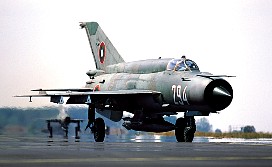
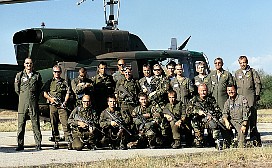
The goal was to assess Command Control & Communication (C³), flying operations, logistical support, medical operations, land operations, etcetera. by following the full cycle of each event. An airborne assessor for instance would observe and check the participating crew from the moment they would receive their Air Tasking Order (ATO) from the Multi-National Air Operations Centre (AOC) going through their mission- planning to the crew-briefing down to the very execution of the ATO and final debriefing. In order to be able to monitor the entire process, the Bulgarian Air Force made available twin-stick aircraft to the airborne assessors for every mission type flown. The target of the team was to assess a minimum of 60% of all the sorties scheduled and during every mission going out, single Mig-29B, SU-22UM or SU-25UB's would directly follow, providing the back-seated airborne assessor with a 'on-the-spot' and 'real time' insight of the activities. Through training lectures and seminars, the multinational Exercise Assessment Team (EAT) which was comprised of a core team from NATO HQs, the Host Nation and the Participating Nations was instructed on the evaluation procedures and criteria. 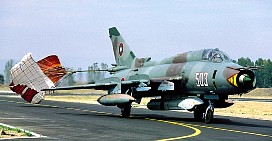
Another major new element in this CK '01 exercise was the introduction of fast-jet reconnaissance missions. Both Sweden and the host nation
Bulgaria provided Recce aircraft together with their mobile photo-laboratories. Sweden sent six AJSF37 Viggens from their Rapid Reaction Force
SWAFRAP. This force is intended to be used for deployment during international Peace Support Operations and draws its Recce Viggens from the
Lulea based 1st division of F21. The Viggens camera nose holds seven cameras, two Ska 31 cameras with 600mm lenses for high level recce and
four Ska24 57-120mm lenses for medium and low level recce. Additionally a Vka702 IR camera is carried in the nose leaving no place for a radar
system. Bulgaria contributed with a single Jambol/Bezmer based Su-22M-4 "Fitter-K" equipped with the enormous centreline fitted KKR Photo/Elint
pod. During the planning process of every mission the choice of sensor (camera), degree of interpretability required (scale, resolution,
stereoscopic, optical), political/operational safety requirements, time of recce & weather conditions, area to be covered, special target
considerations, availability and timeliness are all ingredients essential to ensure that the pilot return from a mission with useful data.
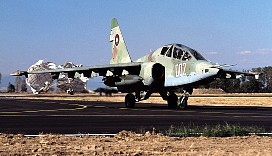
A third new element in the CK '01 peace enforcement operations was the training of a concept similar to the one used in Kosovo when a downed pilot behind enemy lines had to be rescued. In a Pre-planned CSAR operation, Cobra formation comprised of two Austrian Bell 212's packed with US and Austrian special ground forces were guided into hostile territory by the AOC & AWACS. On their ingress route to the objective point (OP), two Bulgarian Hinds shadowed the formation, looking for possible threats. Minutes later a pair of A-10's of the 81 FS joined the package and circled around the formation at distances of between 600 - 1500 feet to provide cover. Once the downed pilot, which identified himself by using a simple hand-held mirror, was located, the pair of Bell 212s landed. Immediately after the go-ahead was given, the US and Austrian special forces disembarked the Twin-Hueys to set up a parameter around the helos and escorted the downed pilot into the cabin. During this phase of the operations the Bulgarian Hinds kept their distance in order not to give away the position of the downed pilot and to distract possible hostile forces. On the way out the A-10's continued circling around the formation at close distances to cover them. Several times the two Hinds were directed by the A-10 pilots to identify and attack possible threats for which the numerous cars on Bulgaria's roads acted as welcome targets. 
When and where refugees are involved, the United Nations High Commissioner for Refugees (UNHCR) usually is designated as the lead agency in complex refugee emergencies world-wide and for the time in a NATO - PfP military-refugee training and simulation exercise, UNHCR was actively participating by setting up and managing a 'real' refugee camp with all its elements, while NATO was co-ordinating the peace-enforcement operation. They were joined in this by the Agency for Refugees (AR), Bulgarian Red Cross, Bulgarian Helsinki Committee and Caritas. The Bulgarian authorities, through the Ministry of Defence, established the refugee camp, with a capacity of about 140 humanitarian- and refugee workers and refugee role players at any one time, that met internationally recommended requirements, such as minimum space, water, sanitary facilities and power supply, etc. The Military Medical Academy, also on the basis of experience gathered in the emergency operation of Kosovo and building a refugee camp in Radusha in the FYROM in 1999, established and operated the emergency medical facility for immediate attention on arrival in the camp. Cases requiring hospital treatment were passed on to the Dutch Field Hospital. During the exercise real world UN procedures were followed and once offloaded by the helicopters, the refugees were first registered and medically screened after which the documentation and interviewing process took place. The next steps involved food & shelter, psychological support and social services & tracing. To ensure the effective co-ordination of civil and military communication and activities during CK '01 a Civil-Military Co-operation (CIMIC) program was set up. FUTURE DEVELOPMENTSThe Bulgarian parliament earlier passed a law granting NATO forces the right to transit Bulgaria or temporarily station troops during the Balkan crisis. Exploratory talks reportedly were conducted also to examine the possibility of stationing unmanned U.S. reconnaissance aircraft in the country to monitor the situation in F.Y.R. of Macedonia. As a contribution to the current war against terrorism, the US was granted the use of an air corridor for the passage of transport planes and helicopters involved in the anti-terrorist operations in Afghanistan. Future regular deployments or even permanent stationing of Nato and US aircraft has become a realistic possibility to boost even more the stability in the region. In the meanwhile the Bulgarian city of Plovdiv was appointed to house the headquarters for the Multinational Peace Force in South-eastern Europe, which incorporates countries like Bulgaria, Albania, Macedonia, Greece, Turkey and Romania. Through their participation in PfP, Bulgaria has earned a great reputation, which has added more points to Bulgaria's NATO invitation scorecard. Chances to a future membership have even increased since Russia recently waived their objections against Nato expansion towards the east. 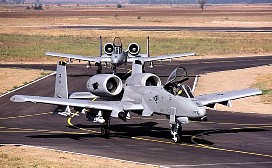
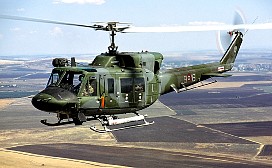
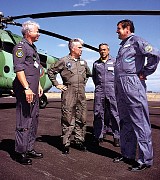
The authors would like to acknowledge the great help and assistance received in writing this article by Maj. Gen. Dimitar Tzvetkov (Bulgarski Voennovazdushni Sili) and Brig. Gen. Francisco de la Vega (AIRSOUTH).
|
|
Website Design: Made|IN|Melon 2021© |
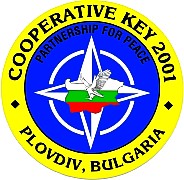
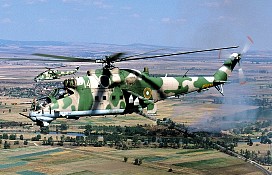
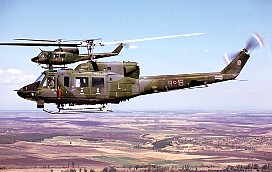
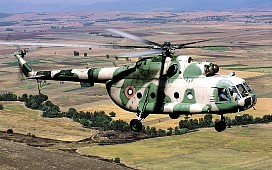
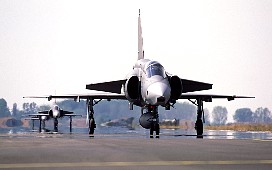
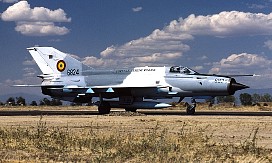 Bulgaria's active participation in the IPP based PfP program is aimed to prepare the country for future membership of the Alliance by improving the operational capabilities and readiness
of the country's armed forces being interoperable with NATO forces. In line with the agreed IPP for 2001, the Republic of Bulgaria
committed itself to participate in some 500 NATO/PfP activities (including 16 NATO exercises and 34 hosted activities and some 50
activities "In the Spirit" of PfP) and include the NATO/PfP exercises Co-operative Key 2001, Co-operative Support 2001 and Co-operative
Poseidonus 2001, all three conducted in Bulgaria. Since 2000 the assessment of IPP is conducted within the framework of the Survey of
the Planning and Review Process (PARP), a NATO-PfP Program designed to foster interoperability with NATO and provide feedback to
Partners to better prepare Partner Armed Forces for combined operations, the cornerstone in all Co-operative Key exercises. PARP is
open to all Partners whereby participation is optional and allows for self-differentiation between Partners both in the extent and
speed of involvement. During the Second PARP Cycle - launched Oct 1996 - the Interoperability Objectives (IOs) were designed to
specifically identify those measures required for Partners' forces to be able to operate successfully with those of the Allies.
In 1998 the Partnership Goals (PGs) replaced the IOs as used in the first two PARP cycles. During the 3rd PARP Cycle, after
consultations in Sofia on 1 March 2000 and 24 March 2000 in Brussels, Bulgaria accepted a package of 82 PGs. 19 of these PGs are
addressed to the Army, 22 PGs - to the Air Force and 16 PGs are addressed to the Navy.
Bulgaria's active participation in the IPP based PfP program is aimed to prepare the country for future membership of the Alliance by improving the operational capabilities and readiness
of the country's armed forces being interoperable with NATO forces. In line with the agreed IPP for 2001, the Republic of Bulgaria
committed itself to participate in some 500 NATO/PfP activities (including 16 NATO exercises and 34 hosted activities and some 50
activities "In the Spirit" of PfP) and include the NATO/PfP exercises Co-operative Key 2001, Co-operative Support 2001 and Co-operative
Poseidonus 2001, all three conducted in Bulgaria. Since 2000 the assessment of IPP is conducted within the framework of the Survey of
the Planning and Review Process (PARP), a NATO-PfP Program designed to foster interoperability with NATO and provide feedback to
Partners to better prepare Partner Armed Forces for combined operations, the cornerstone in all Co-operative Key exercises. PARP is
open to all Partners whereby participation is optional and allows for self-differentiation between Partners both in the extent and
speed of involvement. During the Second PARP Cycle - launched Oct 1996 - the Interoperability Objectives (IOs) were designed to
specifically identify those measures required for Partners' forces to be able to operate successfully with those of the Allies.
In 1998 the Partnership Goals (PGs) replaced the IOs as used in the first two PARP cycles. During the 3rd PARP Cycle, after
consultations in Sofia on 1 March 2000 and 24 March 2000 in Brussels, Bulgaria accepted a package of 82 PGs. 19 of these PGs are
addressed to the Army, 22 PGs - to the Air Force and 16 PGs are addressed to the Navy.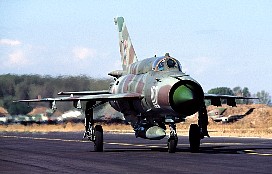
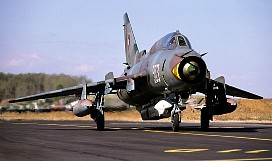
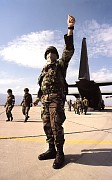
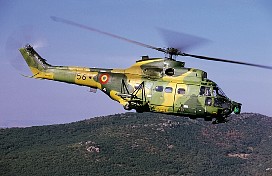
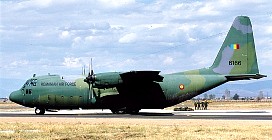
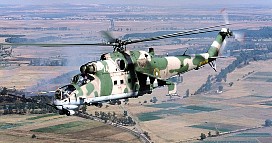 The primary need is to provide adequate opportunities for declared Partner units to train and exercise
together with NATO and to prepare specific national contingents to sustain NATO-led multinational forces. A central element of the concept for
the Alliance is to assess and provide feedback on the Operational Capabilities of declared Partner Forces. This will facilitate the force
generation and tailoring process and enhance the Alliance's capability to sustain long duration operations. Since the ratification of the
program is still in progress, the participation in this years assessment is not to be mistaken for a test to pass or fail and will not result
in a declaration that forces as declared in the "pool of Forces & Capabilities" database are 'ready'.
The primary need is to provide adequate opportunities for declared Partner units to train and exercise
together with NATO and to prepare specific national contingents to sustain NATO-led multinational forces. A central element of the concept for
the Alliance is to assess and provide feedback on the Operational Capabilities of declared Partner Forces. This will facilitate the force
generation and tailoring process and enhance the Alliance's capability to sustain long duration operations. Since the ratification of the
program is still in progress, the participation in this years assessment is not to be mistaken for a test to pass or fail and will not result
in a declaration that forces as declared in the "pool of Forces & Capabilities" database are 'ready'.